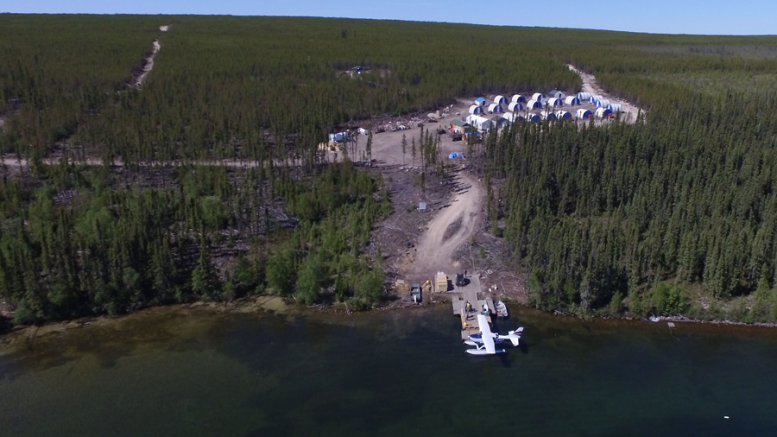VANCOUVER — Explorer NexGen Energy (TSXV: NXE; US-OTC: NXGEF) made headlines earlier this year with an eye-opening maiden resource at its high-grade Arrow uranium deposit in Saskatchewan’s Athabasca basin, and now the emerging world-class discovery has attracted a strategic investment from Hong Kong’s richest man, Li Ka-shing.
On June 2 NexGen entered into a binding term sheet for US$60 million in unsecured convertible debentures with CEF Holdings — a private company 50% owned by Li’s CK Hutchinson Holdings.

Plan view of the Arrow zone. Credit: NexGen Energy.
The deal is unusual, as grassroots exploration companies rarely seek debt financing. From the junior’s perspective, its lack of cash flow tends to make debt underwriting extra risky, while any balance-sheet overhang can dissuade takeover bids.
The debentures will carry a 7.5% coupon over five years, and are convertible into shares at $3.05 at CEF’s option. The conversion price represents a 30% premium to NexGen’s 20-day, volume-weighted average trading price.

Drilling at the Arrow deposit. Credit: NexGen Energy.

Employees work at the Rook I project. Credit: NexGen Energy.
“They are a powerful group, with an incredibly large balance sheet,” CEO Leigh Curyer said during a conference call. “So there’s the capability to finance a much larger project, which could be sufficient to get us into production. Li Ka-shing’s perspective is that he doesn’t just invest for his children, but also his grandchildren and beyond … being China’s richest individual, he has a very good grasp on the country’s nuclear space, and it’s a key investment for CEF.”
NexGen’s cash reserves will total $100 million after the financing. Curyer said that with the capital, the company could take the Rook I property — which hosts the Arrow discovery — through to feasibility and permitting.

Saskatchewan’s Athabasca Basin. Credit: NexGen Energy.
Arrow hosts inferred resources of 3.5 million tonnes of 2.6% uranium oxide (U3O8) for 201.9 million contained lb. U3O8. The deposit hosts the A2 subzone, however, which holds 120.5 million lb. uranium oxide in 410,000 tonnes grading 13.3% U3O8.
NexGen’s agreement doesn’t include any off-take component, which underlines that Arrow could get a lot bigger. The company is on track to drill 75,000 metres this year, and it is generating impressive intercepts.
In late March NexGen released step-out results from hole 16-77c2, around 180 metres southwest of Arrow. The company intersected “strong uranium mineralization,” with lithological profiles similar to the ones near A2.
“We moved our drill rigs when we had that step-out success, which is already tagged into massive pitchblende,” Curyer said. “This is significant because it’s the leading indication of a substantial zone. The mineralization at 180 is identical to what we see in Arrow’s high-grade subzone. So it’s become a priority.”
Arrow’s mineralization occurs within — or near — graphitic mylonites structurally controlled with clay, chlorite and hamatite alteration. There are four parallel structural zones: the A1, A2, A3 and A4 shears. NexGen is drilling the A2 and A3 areas due to higher grades and thicknesses.
Winter and spring drilling returned more high-grade intercepts from the main deposit, including hole 16-76c1, which cut 67.5 metres of 11.3% U3O8.

NexGen Energy’s Arrow uranium project in northern Saskatchewan’s Athabasca basin. Credit: NexGen Energy.
“The funding allows for the further development of Arrow, which based on our winter drill results could get a lot larger,” Curyer said.
“Nearly 100% of our drill holes have hit mineralization, and we figure there will be another two years of full-time drilling before we really understand the deposit. We know the technical characteristics of the project are strong, but we don’t have feasibility numbers yet. We need to know those parameters before we commit to any off-take arrangements,” he added.
NexGen says the cash infusion could fund Arrow’s development over the next three years. The company expects to drill at least 75,000 metres in 2017, while also advancing metallurgical, engineering and permitting activities leading into a feasibility study.
Arrow lies northeast of Fission Uranium’s (TSX: FCU; US-OTC: FCUUF) Patterson Lake South project, which attracted an US$82-million investment from China’s CGN Mining earlier this year. Both deposits consist of unconformity-related, basement-hosted uranium mineralization.
NexGen has traded in a 52-week range of 51¢ to $2.78 per share, and gained 11% on the investment news en route to a $2.50-per-share close at press time. The company has 302 million shares outstanding for a $755-million market capitalization.
“We’re in an unusual circumstance, given the quality of the asset. There’s no encumbrance on Arrow, or our company, with this financing package. The deal gives us the ability to considerably expand [the project] in a non-dilutive manner,” Curyer said.
“Given the characteristics of the [deal], and balancing it against the alternatives, it clearly was the best option for us. We wanted to ensure any strategic investor was aligned with management’s goals for the project, and that was a large part of it,” he said.
BMO Capital Markets analyst Alexander Pearce speculates that the CEF funding should allow NexGen to “undertake development of its world-class Rook 1 project through [roughly 2020].” BMO Research estimates that the company could “feasibly create an underground operation” for $750 million, and calculates a $432-million net present value on the project, assuming a 10% discount rate and US$60 per lb. U3O8.


Be the first to comment on "NexGen scores US$60M from Hong Kong billionaire"